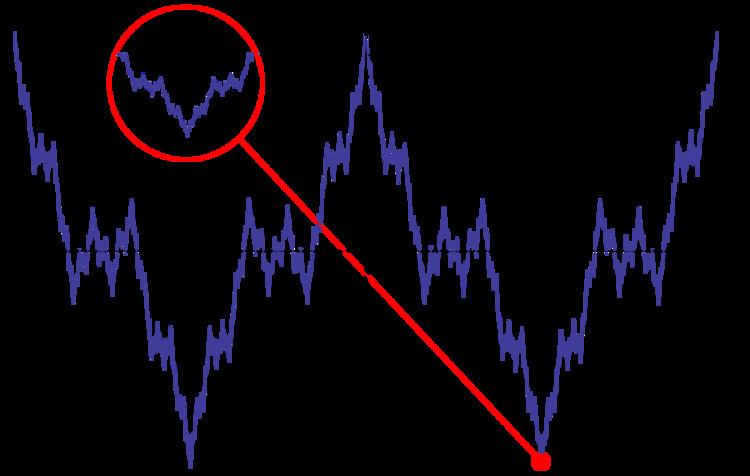 | ||
In mathematics, the Weierstrass function is an example of a pathological real-valued function on the real line. The function has the property of being continuous everywhere but differentiable nowhere. It is named after its discoverer Karl Weierstrass.
Contents
Historically, the Weierstrass function is important because it was the first published example (1872) to challenge the notion that every continuous function was differentiable except on a set of isolated points.
Construction
In Weierstrass' original paper, the function was defined as the sum of a Fourier series:
where
The minimum value of
Despite never being differentiable, the function is continuous: Since the terms of the infinite series which defines it are bounded by ±an and this has finite sum for 0 < a < 1, convergence of the sum of the terms is uniform by the Weierstrass M-test with Mn = an. Since each partial sum is continuous, by the uniform limit theorem, it follows that f is continuous. Additionally, since each partial sum is uniformly continuous, it follows that f is also uniformly continuous.
Naïvely it might be expected that a continuous function must have a derivative, or that the set of points where it is not differentiable should be "small" in some sense. According to Weierstrass in his paper, earlier mathematicians including Gauss had often assumed that this was true. This might be because it is difficult to draw or visualise a continuous function whose set of nondifferentiable points is something other than a countable set of points. Analogous results for better behaved classes of continuous functions do exist, for example the Lipschitz functions, whose set of non-differentiability points must be a Lebesgue null set (Rademacher's theorem). When we try to draw a general continuous function, we usually draw the graph of a function which is Lipschitz or otherwise well-behaved.
The Weierstrass function could perhaps be described as one of the very first fractals studied, although this term was not used until much later. The function has detail at every level, so zooming in on a piece of the curve does not show it getting progressively closer and closer to a straight line. Rather between any two points no matter how close, the function will not be monotone. The Hausdorff dimension D of the graph of the classical Weierstrass function is bounded above by 2 + ln(a)/ln(b), (where a and b are the constants in the construction above) and is generally believed to be exactly that value, but this had not been proven rigorously. Notice that 1 < D < 2 if ab > 1.
The term Weierstrass function is often used in real analysis to refer to any function with similar properties and construction to Weierstrass' original example. For example, the cosine function can be replaced in the infinite series by a piecewise linear "zigzag" function. G. H. Hardy showed that the function of the above construction is nowhere differentiable with the assumptions 0 < a < 1, ab ≥ 1.
Hölder continuity
It is convenient to write the Weierstrass function equivalently as
for
for all x and y. Moreover, Wα is Hölder continuous of all orders α < 1 but not Lipschitz continuous.
Density of nowhere-differentiable functions
It turns out that the Weierstrass function is far from being an isolated example: although it is "pathological", it is also "typical" of continuous functions:
